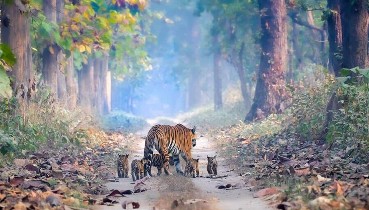
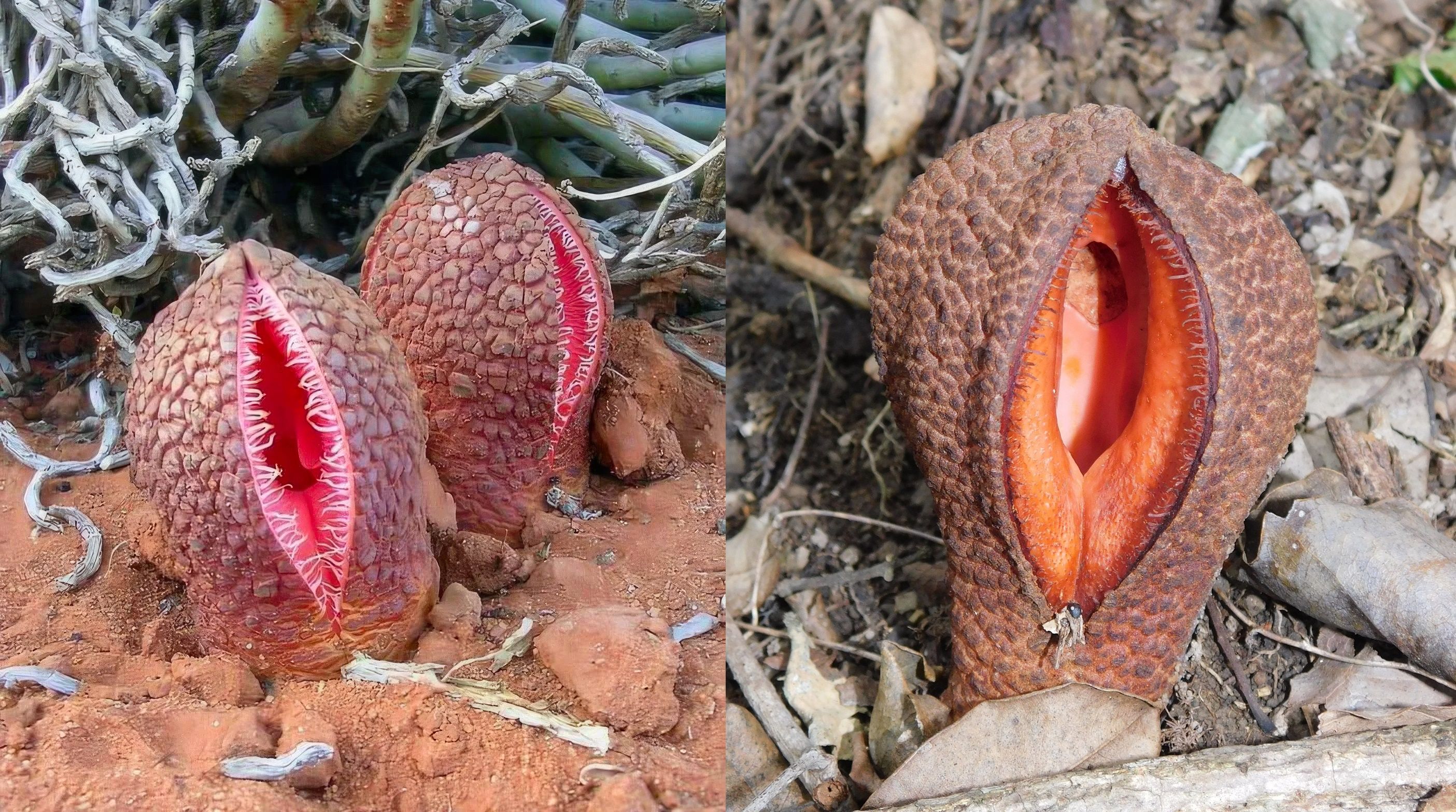
No leaves or chlorophyll are visible on Hydnora africana plants.
No leaves or chlorophyll are visible on Hydnora africana plants. The plants only become visible when the flowers protrude through the soil after good rains have fallen. Under favourable conditions it takes at least one year for a bud to develop into a mature flower.

Derivation of name and historical aspects
There are two genera that belong to the Hydnoraceae family; Prosopanche, which is restricted to the eastern half of South America, and Hydnora, which is a strictly African genus. Collectively Prosopanche and Hydnora contain between 10 and 15 species.
The genus name Hydnora is taken from the Greek word hydnon, which means fungus-like and refers to the resemblance that this species has to the fungus genus Hydnum. The specific name africana means from Africa.
For hundreds of years, jackal food was well known by the indigenous inhabitants of southern Africa. It was only from 1774 that the plant was introduced to science in the western world by the father of South African botany, Carl Thunberg. This very active and well-travelled Swedish botanist discovered and collected the first known records of H. africana near Calvinia in the Hantam district of South Africa. When he first saw the plant he thought it was a fungus and named it Hydnus after the fungus group. Subsequently the genus name changed to Hydnora.
Ecology
No leaves or chlorophyll are visible on Hydnora africana plants. The plants only become visible when the flowers protrude through the soil after good rains have fallen. Under favourable conditions it takes at least one year for a bud to develop into a mature flower.
The flowers bears no resemblance to normal flowers except for its bright salmon to orange-red colour on the inside, which fulfils the same purpose as normal flowers, namely to advertise the plant. White bait bodies are found on the inner base of the flowers. The bait bodies play a very important role in the life cycle of the plant. They omit a putrid odour to attract various carrion beetles and other insects which become trapped in the flowers. Numerous stiff bristles are found on the inner surface of the perianth lobes which prevent the trapped insect from escaping. After feeding on the bait bodies, the trapped insect drops down the flower tube onto the anthers, collecting pollen all over its body. It then drops even further down onto the soft cushion-shaped stigma and thus pollinates the flower.
Fully grown, ripe fruits of Hydnora africana may measure up to 80 mm across and contain up to 20 000 seeds per fruit. The brown pinhead-sized seeds are embedded in an edible gelatinous pulp with a slightly sweet and starchy taste. These fruits are favoured by mammals such as porcupines, moles, baboons, jackal and also birds. The seeds are not digested and thus are in an ideal state for germination when excreted by animals.
Not much is known about the germination of the seeds except that they are more likely to germinate in close proximity to the host plant. The germinated seed develops a primary root (primary haustorium) which establishes the first attachment point to the host. After the plant has grown and spread, it may develop several secondary haustoria, attaching itself to the same or different host nearby.

The plants have modified their roots in such a way as to ensure invasion of the potential host's tissue. It is thought that the plant excretes powerful enzymes that dissolve away the hard tissue of the host in order to attach itself. The point of attachment is called the haustorium (haustorial roots) and is similar to a graft where two separate members of the union develop together in harmony. Once established, the plant is able to live off the nourishment from the host and quickly develops a matrix of underground stems from which the flower buds develop and eventually emerge above the ground.
Unlike Hydnora africana, the sister species H. johannis parasitises the more superficial roots of Acacia karroo (sweet-thorn). The host-specific preferences of these two related species are very interesting, and say a lot about the evolution and adaptability of the genus.
Uses
The fruit of Hydnora africana is said to be a traditional Khoi food, but there are no recorded details to confirm this. The fruit is delicious when baked on a fire, and has a sweetish taste. Jackal food is used in a series of Cape dishes as recorded in the recipe book of Betsie Rood, Kos uit die Veldkombuis (Rood 1994). One of the recipes describes how the fruit pulp can be mixed with cream to make a delicious dessert. The fruit is extremely astringent and has been used for tanning and preserving fishing nets. Diarrhoea, dysentery, kidney and bladder complaints are all treated with infusions and decoctions of Hydnora africana. Infusions used as a face wash also treat acne.
Growing Hydnora africana
Hydnora africana is not grown as a cultivated plant due to its dependence on its Euphorbiaceae hosts. In the wild, it grows primarily by means of seeds which are dispersed by birds and small mammals that feast on its fruits.

Recommended Videos
 20 Perfectly Timed Nature Photos 3799 views
20 Perfectly Timed Nature Photos 3799 views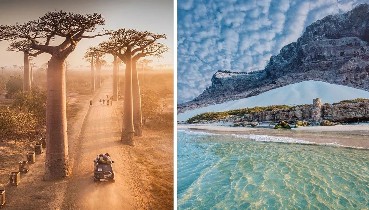 Socotra Island In Yemen1842 views
Socotra Island In Yemen1842 views-
Advertisements
 Skeleton Coast: The No-Go Zone at the Edge of the World That God Made in Anger260 views
Skeleton Coast: The No-Go Zone at the Edge of the World That God Made in Anger260 views This 100-Million-Year-Old Bird Trapped in Amber Is The Best We've Ever Seen140 views
This 100-Million-Year-Old Bird Trapped in Amber Is The Best We've Ever Seen140 views The squirrel cuckoo (Piaya cayana)184 views
The squirrel cuckoo (Piaya cayana)184 views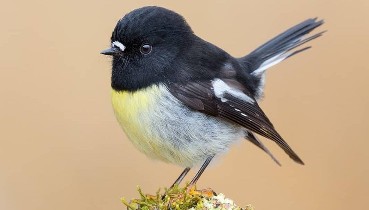 The tomtit fits perfectly95 views
The tomtit fits perfectly95 views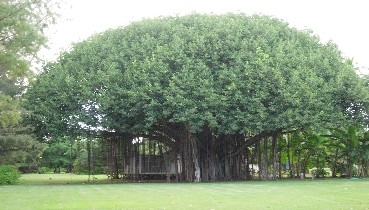 500-year-old banyan tree gets tourist spot status in Odisha1519 views
500-year-old banyan tree gets tourist spot status in Odisha1519 views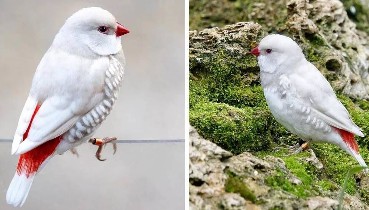 Meet The Fascinating Silver Diamond Firetail595 views
Meet The Fascinating Silver Diamond Firetail595 views



